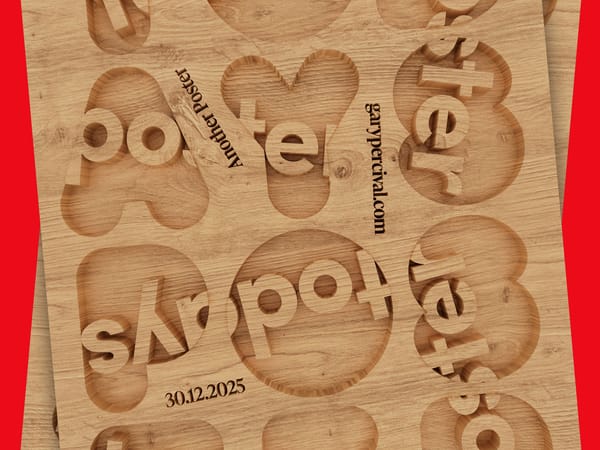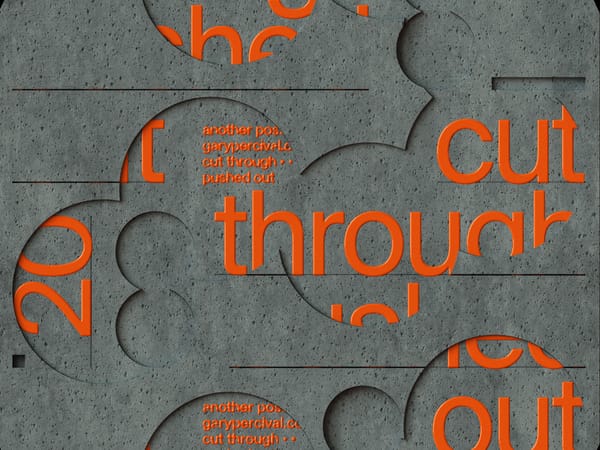Stop Thinking With Someone Else’s Brain
"It feels like action, but it’s imitation—and imitation can’t carry a meaningful creative career."

In the age of advice overload, one of the hardest things to do as a creative is to think for yourself.
Everywhere you turn, someone is offering a shortcut, a method, a blueprint:
- “This is how I got 10x client leads.”
- “Here’s what every freelancer must do in 2025.”
- “Avoid these 3 mistakes if you want to succeed.”
The problem isn’t the abundance of ideas. It’s the overconsumption of them. We take in so much advice, so many frameworks, and so many filtered opinions that it becomes hard to hear our own thoughts over the noise.
And that’s where the trap sets in: you begin to think with someone else’s brain.
You follow strategies you don’t fully believe in.
You mimic design trends that don’t match your values.
You price your work based on someone else’s “rule”.
You judge your progress against someone else’s highlight reel.
It feels like action, but it’s imitation. And imitation—while helpful in small doses—can’t carry a meaningful creative career.
Why We Do It
Let’s start with empathy. This isn’t about being lazy or unoriginal. It’s about being overwhelmed.
Freelancing, designing, and creating are uncertain paths. There’s no clear plan. No annual review. No step-by-step manual to follow. And when things get unclear, it’s natural to reach for someone else’s map.
We tell ourselves:
- “They seem to have figured it out.”
- “Maybe if I copy their structure, I’ll get their results.”
- “If it worked for them, it should work for me.”
But here’s the uncomfortable truth: their brain isn’t wired like yours. Their path isn’t shaped like yours. And their solutions, while possibly useful, weren’t built for your context.
Secondhand Thinking Is Safe—And That’s the Problem
Taking someone else’s advice and applying it blindly feels productive. It feels like progress. But often, it’s procrastination in disguise.
Instead of sitting with your own uncertainty or wrestling with your own decisions, you defer. You act based on borrowed conviction.
And over time, your work—your business, your ideas, your designs—starts to lose its edge. It becomes polished, yes. Efficient, maybe. But also… hollow.
Because it’s missing something essential: your point of view.
Your Best Work Requires Your Own Thinking
Every creative breakthrough starts with a personal lens. Whether you’re building a freelance practice, designing a brand, writing copy, or making art—the work that sticks is the work that’s rooted in something real.
And that realness can’t be outsourced.
You can learn from others. You can be inspired by others. But the final decisions—the direction, the tone, the boundaries, the bold moves—must be yours.
Because the creative field doesn’t reward sameness. It rewards distinction.
And distinction doesn’t come from thinking with someone else’s brain.
Signs You’re Thinking With Someone Else’s Brain
You might be doing it without even realising. Here are a few common red flags:
You can’t explain why you’re doing something
You’re following a system or style, but if asked “Why this approach?”, you draw a blank—or default to “I heard it works.”
You’re constantly switching strategies
One week it’s “cold email 100 prospects”, the next it’s “build in public”, then it’s “scale via ads”. You’re not iterating—you’re constantly jumping between strategies from different voices.
Your work feels successful but not satisfying
From the outside, things look good. You’re getting likes, clients, maybe even money. But it all feels disconnected. Like it’s happening to you, not through you.
You seek permission to act
You wait for a podcast or influencer to validate your instincts. You already know what you want to do—but you don’t trust yourself to do it.
How to Reclaim Your Own Thinking
This isn’t about ignoring all external input. That’s not realistic—or helpful. But you can shift from passive absorption to active engagement. Here’s how:
Slow Down Your Consumption
It’s easy to binge on advice. But wisdom needs digestion. The next time you read a thread, watch a tutorial, or listen to a podcast, pause. Ask:
- What’s the core idea here?
- Do I agree with it?
- How does this apply (or not apply) to my situation?
A slower pace leads to deeper understanding—and fewer copy-paste decisions.
Test, Don’t Adopt
Instead of fully committing to someone else’s method, test it. Run a small experiment. See how it feels. See what results it produces for you.
For example, before committing to a full cold outreach campaign, try sending five tailored emails and track the response.
Thinking for yourself isn’t about rejecting all help. It’s about being a curious filter—not a sponge.
Reflect in Writing
Get your thoughts out of your head and onto paper (or screen). Journaling, voice notes, mind maps—whatever works. Reflection turns noise into clarity. It shows you what you really think.
And when you capture your own ideas, you start to see patterns. Priorities. Direction. That’s where your unique voice comes from.
Create Before Consuming
Before you check what others are doing today, make something of your own. Sketch. Write. Draft. Edit. Design.
Lead with your brain—then learn from others.
This small reversal changes everything. It puts you back in the creative driver’s seat.
The Confidence to Trust Your Own Thoughts
One of the real challenges here isn’t a lack of knowledge. It’s a lack of trust.
We often know what we want to do, but we hesitate. Why? Because:
- It doesn’t match what everyone else is doing.
- It might not be the “efficient” choice.
- It feels risky to trust your gut without external validation.
But the people we admire most—designers, artists, writers, and innovators—aren’t following a checklist. They’re following curiosity. Conviction. Craft.
You don’t need to be a rebel. But you do need to back yourself.
You’re the one who knows what kind of work excites you. What kind of life you want to build. What kind of client feels like a dream—and which ones drain you.
Trust that. Honour that. Build from that.
Thinking for Yourself Is a Creative Edge
In a world of algorithms, automation, and endless content, original thought is rare. And therefore, valuable.
When you think for yourself:
- Your portfolio becomes more distinctive.
- Your creative decisions feel more aligned.
- Your freelance business reflects you, not a playbook.
- You attract the kind of clients and collaborators who resonate with your approach.
And perhaps most importantly—you feel proud of what you’re building. Because it’s yours.
Final Thoughts
You’re going to be exposed to a lot of noise in your creative journey. Strategies. Hot takes. Templates. Blueprints. A thousand voices telling you what to do, how to do it, and why their way is the best way.
Some of it will be helpful. Much of it won’t.
Your job isn’t to copy faster. It’s to filter better.
And the only way to build something meaningful—something original, sustainable, and fulfilling—is to stop thinking with someone else’s brain… and start using your own.
You’ve got everything you need.
Now think it through—and make it yours.



